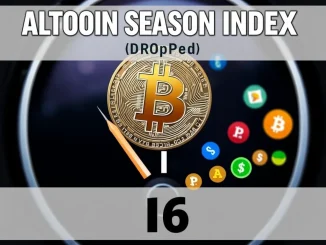
Hold onto your hats, crypto enthusiasts! The U.S. spot Ethereum ETF market just experienced a jolt. On April 10th, these much-anticipated investment vehicles saw a combined net outflow of a significant $38.8 million. This marks the third consecutive day of investors pulling back, according to data wizards at Farside Investors. Is this just a blip on the radar, or could it signal something more profound for the future of spot Ethereum ETFs and the broader crypto landscape? Let’s dive deep into the numbers and unravel what this might mean for you.
Why are Ethereum ETF Outflows Causing Concern?
Three consecutive days of outflows from Ethereum ETFs is definitely something to pay attention to. While the crypto market is known for its volatility, sustained outflows can indicate shifting investor sentiment. Let’s break down which ETFs are feeling the pressure and which ones are bucking the trend.
Here’s a quick rundown of the ETF-specific outflows on April 10th:
- Fidelity’s FETH: Bearing the brunt of the outflows, FETH saw a hefty $36 million exit.
- VanEck’s ETHV: ETHV experienced a $4.4 million outflow.
- Bitwise’s ETHW: Not far behind, ETHW recorded a $2.5 million outflow.
- Grayscale’s ETHE: ETHE also felt the pinch with a $2.3 million outflow.
Interestingly, amidst this sea of red, there was one green island:
- BlackRock’s ETHA: Defying the trend, ETHA actually saw a net inflow of $6.4 million.
This divergence raises some intriguing questions. Why are investors pulling funds from most ETH ETFs while simultaneously injecting capital into BlackRock’s ETHA? Is this a flight to quality, a specific reaction to fund management, or just random market noise? Let’s explore some potential factors.
Decoding the Ethereum ETF Outflows: What’s Really Happening?
Several factors could be contributing to these Ethereum ETF outflows. It’s rarely just one thing in the complex world of crypto markets. Let’s consider a few key possibilities:
Profit Taking After Rallies: The crypto market, including Ethereum, has seen significant rallies in the lead-up to and following the spot Bitcoin ETF approvals. Investors who bought in earlier might be taking profits off the table. ETFs provide a convenient and regulated way to do just that.
Market Correction Fears: After periods of strong growth, markets often experience corrections. Investors might be anticipating a broader market pullback and reducing their exposure to riskier assets like crypto, even through ETFs. Crypto ETF investments, while offering diversification, are still subject to the overall sentiment in the digital asset space.
Macroeconomic Uncertainty: Global economic conditions, inflation concerns, and interest rate hikes can all influence investor behavior. Uncertainty in the macroeconomic environment often leads investors to become more risk-averse, potentially triggering outflows from assets perceived as higher risk, such as cryptocurrencies and related ETFs.
Fund-Specific Factors: The differing performance between ETHA and other ETFs suggests that fund-specific factors could be at play. Management fees, fund holdings, or investor perception of fund managers could influence inflows and outflows. BlackRock’s established reputation and massive asset management scale might be giving investors more confidence, leading to continued inflows into ETHA even amidst broader outflows.
Regulatory Landscape Concerns: While spot Bitcoin ETFs are approved, the regulatory landscape for crypto remains dynamic and, in some regions, uncertain. Any perceived increase in regulatory scrutiny or negative news could trigger investor unease and lead to outflows from crypto-related investment products.
The Contrasting Case of BlackRock’s ETHA: Why the Inflows?
The $6.4 million inflow into BlackRock’s ETHA while most other spot Ethereum ETFs bled red is a significant point of divergence. What could explain this anomaly? Several factors could be at play:
BlackRock’s Brand and Reputation: BlackRock is the world’s largest asset manager. Their brand carries immense weight and trust among institutional and retail investors alike. This established credibility might make ETHA a preferred choice for investors seeking exposure to Ethereum through an ETF, especially during times of market uncertainty.
First-Mover Advantage (Partially): While not the very first to launch, BlackRock was among the first wave of spot Bitcoin ETF issuers and has quickly become a dominant player in that space. This success and experience could translate to investor confidence in their Ethereum ETF offering as well.
Lower Fee Structure: While fee details vary and can change, BlackRock often positions its ETFs with competitive fee structures. Lower fees can be a significant draw for investors, especially in the ETF market where expense ratios are closely scrutinized.
Strategic Marketing and Distribution: BlackRock possesses unparalleled marketing and distribution capabilities. Their ability to reach a vast network of advisors and investors globally likely contributes to consistent inflows, even when the broader sector faces headwinds.
Impact on Ethereum Price and the Broader Crypto Market
What does this all mean for the Ethereum price impact and the broader crypto market? While one day of net outflows, or even three, doesn’t necessarily dictate a long-term trend, it’s crucial to understand the potential implications:
Short-Term Price Pressure: Outflows from ETFs can exert downward pressure on the underlying asset’s price, at least in the short term. If ETF providers are selling ETH to meet redemption requests, this can increase selling pressure in the market.
Sentiment Indicator: ETF flows are often viewed as a barometer of investor sentiment. Sustained outflows could suggest a shift in sentiment towards Ethereum, or at least a temporary cooling off after the initial excitement surrounding spot ETFs.
Broader Market Correlation: Ethereum’s price is closely correlated with Bitcoin and the overall crypto market. Negative news or outflows in one area can sometimes spill over and affect the entire sector. However, it’s important to remember that correlation is not causation, and many other factors influence market movements.
Long-Term ETF Growth Potential: Despite these recent outflows, the long-term potential for ETH ETFs remains significant. They provide a regulated and accessible way for institutional and retail investors to gain exposure to Ethereum. Market fluctuations are normal, and the ETF market is still relatively new. Long-term success will depend on sustained investor interest in Ethereum and the overall crypto asset class.
Navigating the Ethereum ETF Landscape: Key Takeaways for Investors
So, what should investors make of these Ethereum ETF outflows? Here are some actionable insights:
Don’t Panic Sell: Three days of outflows is not necessarily a cause for panic. Market corrections and fluctuations are normal. Avoid making impulsive decisions based on short-term market noise.
Monitor ETF Flows Closely: Keep an eye on daily and weekly ETF flow data from reputable sources like Farside Investors. This data can provide valuable insights into investor sentiment and potential market trends.
Diversify Your Crypto Portfolio: Don’t put all your eggs in one basket. Diversification across different cryptocurrencies and investment strategies can help mitigate risk.
Consider Long-Term Perspective: Investing in crypto, especially through ETFs, should be viewed as a long-term strategy. Focus on the fundamentals of Ethereum and the broader crypto ecosystem rather than getting swayed by short-term market swings.
Do Your Own Research (DYOR): Before investing in any cryptocurrency or ETF, conduct thorough research. Understand the risks involved and make informed decisions based on your own financial situation and risk tolerance.
Conclusion: Ethereum ETFs – A Marathon, Not a Sprint
The recent $38.8 million Ethereum ETF outflow is a noteworthy event, serving as a reminder that the crypto market, even in its more institutionalized form through ETFs, remains dynamic and subject to shifts in investor sentiment. While these outflows might raise eyebrows and trigger short-term price fluctuations, it’s crucial to maintain a long-term perspective. The ETH ETF market is still in its early stages, and its growth trajectory will be shaped by a multitude of factors, including regulatory developments, technological advancements in the Ethereum ecosystem, and broader macroeconomic conditions. For investors, staying informed, maintaining a diversified portfolio, and focusing on long-term fundamentals are key to navigating the exciting, yet often volatile, world of crypto ETFs.



